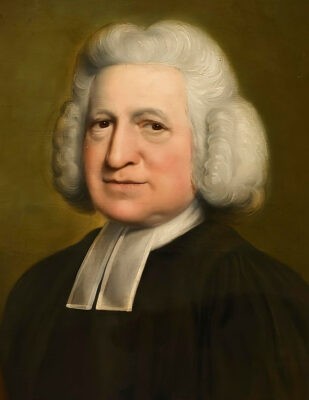The Story Behind: Rejoice, the Lord Is King

Born in 1707 into an Anglican parsonage in England, Charles Wesley would go on to pen an astonishing 6,500 hymns over his lifetime. Alongside his brother John, he was also a key leader in the evangelical revival and Methodist movement that swept 18th century England and beyond. Millions of voices still sing his words today in classics like “Hark! The Herald Angels Sing,” “Christ the Lord Is Risen Today,” and “Love Divine, All Loves Excelling.”
But there is one hymn of Wesley’s that especially captures the exultant joy and triumphant hope found in Christ’s kingship. “Rejoice, the Lord is King!” has resonated in the hearts of believers for nearly 300 years, inviting us to lift our praise to heaven’s exalted Lord. Let’s explore the story and message behind this magnificent hymn.
Celebrating Christ’s Reign
Charles Wesley first published “Rejoice, the Lord is King” in 1744 in the collection Moral and Sacred Poems. He wrote it as a poetic celebration of the kingship of Jesus Christ over all creation. The lyrics draw upon the messianic imagery of Psalm 97 and the exaltation of Christ described in the opening chapters of Hebrews and Revelation.
Rejoice, the Lord is King! Your Lord and King adore;
Mortals give thanks and sing, and triumph evermore;
Lift up your heart, lift up your voice;
Rejoice, again I say, rejoice!
The hymn is a powerful confession of faith, beginning each stanza with a confident assertion about the person and work of Christ. He is the reigning and returning King, the exalted God-man who “sits at God’s right hand till all His foes submit.” Interwoven throughout are echoes of the great Christological hymn of Philippians 2, which speaks of every knee bowing and every tongue confessing Jesus Christ is Lord.
So why did Wesley feel compelled to write this glorious ode to Christ the King? As an evangelist and pastor, he knew firsthand the challenges facing the Methodist societies and the masses to whom he preached. In an age marked by political upheaval, societal ills, and spiritual malaise, Wesley wanted to lift people’s eyes above their circumstances to the One whose kingdom cannot fail. He sought to impart courage to persecuted believers and instill hope in the face of life’s trials.
England’s green and pleasant land was not always so pleasant for Wesley and his followers. They often faced intense opposition and even mob violence for their bold evangelical preaching. What better way to strengthen the flock than to put songs of unshakeable hope in their hearts? “Rejoice, the Lord is King” was a rallying cry to stand firm in the faith, come what may. For if Christ is reigning on heaven’s throne, then His people have nothing to fear.
Verse three proclaims:
His kingdom cannot fail, He rules o’er earth and Heav’n,
The keys of death and hell are to our Jesus giv’n;
Lift up your heart, lift up your voice;
Rejoice, again I say, rejoice!
Setting the Hymn to Music
The most common tune used for “Rejoice, the Lord is King” is DARWALL, composed by Anglican clergyman John Darwall in 1770. But did you know that the great composer George Frideric Handel also wrote a tune for Wesley’s hymn?
The fascinating story behind Handel’s involvement dates back to a meeting between Charles Wesley and Handel at the home of Mr. and Mrs. Rich. Mrs. Rich had been converted to Methodism through Wesley’s powerful preaching, and as a gesture of gratitude, she requested that Handel compose tunes for some of Wesley’s hymns, including “Rejoice, the Lord is King.” Handel, who was friends with Wesley and at the height of his career, graciously agreed.
The composer had recently premiered his monumental oratorio Messiah, with a libretto written by Charles Jennens. Jennens was a wealthy patron of the arts who resided at Gopsall Hall, a grand estate in Leicestershire. It was after this very estate that Handel chose to name the tune he composed for “Rejoice, the Lord is King,” perhaps as a nod of respect to Jennens, his collaborator on Messiah, who may have facilitated or encouraged the commission from the Riches.
And so GOPSAL was born – a regal, festive melody befitting a hymn that extols Christ’s kingship. Hymnologist J.R. Watson notes that GOPSAL was composed in Handel’s characteristic joyful style, punctuated by the trumpets and kettledrums that were the composer’s signature. Handel’s musical version of the hymn was the embodiment of the King of kings coming into His kingdom with pomp and celebration. One can almost hear the choir and orchestra of heaven resounding as Christ ascends to His throne!
As glorious as Handel’s tune is, it never quite gained the popularity of DARWALL, which remains the melody most often paired with Wesley’s text today (and the tune used in the Hymncharts arrangement you hear on this page.) But what a gift we have in both of these musical settings! Whether sung to the jubilant strains of DARWALL or the regal fanfare of GOPSAL, “Rejoice, the Lord is King” invites us to join the eternal chorus exalting our sovereign Lord.
A Hymn Full of Theology
At its core, “Rejoice, the Lord is King” is an intensely theological hymn. Each stanza is densely packed with Biblical truths about the person and work of Jesus Christ. Wesley’s stirring words remind us that our faith is anchored in the objective realities of who Christ is and what He has accomplished for us, not in our subjective feelings or circumstances.
Consider how much sound doctrine is covered in just the second verse:
Jesus the Savior reigns, the God of truth and love;
When He had purged our stains He took His seat above;
Lift up your heart, lift up your voice;
Rejoice, again I say, rejoice!
Here we see Christ’s divinity and incarnation – He is the Savior who reigns as the God of truth and love. We encounter his atoning work on the cross, purging the stains of our sin. And we marvel at His ascension and exaltation, having taken His seat above at the Father’s right hand. That’s enough glory to fuel infinite choruses of heartfelt praise!
The hymn goes on to expound on Christ’s unshakeable kingdom, His ultimate triumph over all His foes, and His coming again as our great Judge and Deliverer. This is no shallow “happy clappy” ditty, but a meaty confession of biblical Christology. It calls for an engaged mind as well as an enflamed heart.
Verse five declares:
He all His foes shall quell, shall all our sins destroy,
And every bosom swell with pure seraphic joy;
Lift up your heart, lift up your voice;
Rejoice, again I say, rejoice!
An Invitation to Praise
Perhaps the most noteworthy feature of “Rejoice, the Lord is King” is its frequent invitations to praise. Five of the original six stanzas begin with the imperative “Rejoice,” and the refrain repeats the exhortation: “Lift up your heart, lift up your voice; rejoice, again I say, rejoice!”
These are not clichéd commands to drum up positive feelings. They are a serious summons to ground our joy in the solid truths of who Christ is and what He has done, even in the midst of life’s sorrows. This call to rejoice is modeled after the apostle Paul’s exhortation in Philippians 4:4 – “Rejoice in the Lord always; again I will say, rejoice!” Importantly, Paul issued this call while imprisoned in Rome in less than ideal circumstances. Whether on a hymn writer’s desk in England or an apostle’s parchment in a prison cell, the call to rejoice in the Lord is not dependent on our circumstances but on Christ Himself.
A Legacy for the Ages
Charles Wesley never could have imagined the influence his hymn would have when he first penned it. For nearly three centuries, “Rejoice, the Lord is King” has been traveled the globe, crossing oceans and mountains, traversing time and cultures. It has encouraged believers facing persecution, anchored people of faith in times of tribulation, and lifted downcast eyes to heaven’s throne. Missionaries have carried it to foreign shores, parents have sung it over cradles and sick beds, and saints have whispered it on their deathbeds. The hymn has found a cherished place in the liturgies and hymnals of many churches and traditions.
And with each new generation, its message remains as relevant and needed as ever. In a world still marked by chaos and crisis, Wesley’s clarion call to rejoice in our reigning Lord is truly good news worth singing about. Whatever our circumstances, we can lift up our hearts and voices to celebrate the One whose kingdom is unshakeable and whose love is unfailing. So let us join our voices with myriads throughout the ages and realms of glory to declare:
Rejoice in glorious hope! Jesus the Judge shall come,
And take His servants up to their eternal home.
We soon shall hear th’ archangel’s voice;
The trump of God shall sound, rejoice!
Frequently Asked Questions (FAQ)
Why did Paul say rejoice in the Lord?
In his letter to the Philippians, Paul encourages believers to “rejoice in the Lord always” (Phil. 4:4), even as he himself is writing from prison. Paul’s call to rejoice in the midst of difficult circumstances points to the profound truth that true joy is found not in our external situations, but in our relationship with Christ and the inner working of His Spirit in our lives.
What is the story behind the hymn Rejoice the Lord is King?
“Rejoice, the Lord is King” was written by Charles Wesley in 1744 as a joyful celebration of Christ’s kingship and sovereignty over all creation. The hymn’s original tune was composed by George Frideric Handel, a friend of Wesley’s, but it is now most commonly sung to the melody DARWALL, named after its composer John Darwall, who wrote it for the text of Psalm 148 in 1770.
Download sheet music, chord charts, tracks and multitracks for Rejoice, the Lord Is King exclusively here at Hymncharts.com. You won’t find this arrangement on any other website.


